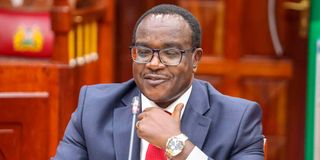
Education Cabinet Secretary Julius Migos Ogamba.
Kenya is planning to export its trained but unemployed teachers in a bid to reduce the number of unemployed graduates, which now stands at over 400,000, Education Cabinet Secretary Julius Ogamba has revealed.
The development comes as the country's public schools, especially junior secondary schools, are grappling with a critical shortage of teachers.
Appearing before the Senate on Wednesday, the CS revealed that the strategy, without giving numbers, is to send a number of trained but unemployed teachers who are currently jobless to teach abroad.
Mr Ogamba indicated that plans are afoot to have Kenya listed as an English-speaking country to qualify for sending the teachers to work abroad.
He explained that it is a requirement to have a country listed as a native English-speaking nation to qualify to send teachers to work abroad.
"We have over 400,000 qualified teachers who don't have jobs. The strategy to reduce the number is that we are trying to see if the teachers can go to other countries to teach because we have some who have been out for 10 years," said Mr Ogamba.
"Once we make that proposal and it is approved, then we will be able to reduce the number of teachers we have who are unemployed," he added.
The unemployment crisis reared its ugly head when over 356,000 unemployed teachers submitted their applications for 14,000 jobs advertised by the Teachers Service Commission (TSC) in June 2022.
Post-primary teaching positions attracted the most applicants, with 219,311 teachers expressing interest in just 4,000 vacancies.
Two years later, the crisis manifested itself again when a total of 314,117 unemployed teachers applied for the 46,000 vacancies advertised by the TSC in October 2024, highlighting the high unemployment rate among graduates.
According to the applications, some 144,177 teachers applied for the 39,500 permanent and pensionable posts available in junior schools across the country.
A further 93,646 teachers applied for the 6,000 posts available in primary schools, while the TSC received 76,294 applications for 450 posts in secondary schools.
The number of unemployed trained teachers has risen steadily since 1998, when the government changed its teacher recruitment policy from supply to demand-driven in a bid to rein in the ballooning national wage bill.
In 2018, TSC chief executive Nancy Macharia said there were more than 290,000 trained teachers who were unemployed, some of whom had been trained as far back as 2008.
By 2020, Kenya had more than 290,000 trained teachers who were unemployed, but by 2021, the number had risen to more than 300,000 teachers who were currently qualified and registered with TSC but not yet absorbed into the public service.
The bulk of the unemployed teachers are said to hold the now obsolete P1 teaching certificate.
Some senators described the plan by President William Ruto's administration as an admission that the country's future is bleak with just over 317,069 teachers employed by TSC.
"The minister's submission is a confirmation that our future is bleak. The CS says we have teachers without jobs, children without teachers and he wants to export teachers. It is a mess," said Homa Bay Senator Moses Kajwang'.
New schools
In the TSC's five-year strategic plan between 2019 and 2023, the commission estimated a teacher shortage of 99,081 (2019); 98,448 (2020); 97,826 (2021); 97,214 (2022) and 96,612 (2023).
The shortage has been attributed to rapid growth in enrolment, the establishment of new schools and the expansion of existing institutions.
The government's policy of 100 per cent transition of pupils from primary to secondary school also contributed to the shortage of teachers.
However, CS Ogamba said the huge number of unemployed graduates is a result of constraints brought about by inadequate funding and lack of budget.
He said ministries are struggling financially as a result of Sh346 billion budget cuts following the withdrawal of the controversial Finance Bill, 2024 by President Ruto due to sustained pressure from the Gen Zs.
The government had relied on the bill to raise Sh347 billion in the financial year ending June 30, 2025, to plug the government's Sh3.92 trillion deficit.
The country is also grappling with low revenue collection where the Kenya Revenue Authority, despite revising its revenue target downwards from Sh2.768 trillion to Sh2.5 trillion in the financial year ending June 30, 2024, managed to collect only Sh2.22 trillion, missing the revised target by Sh276 billion.
Schools at all levels have a teacher shortage that the government has been unable to address for years.










